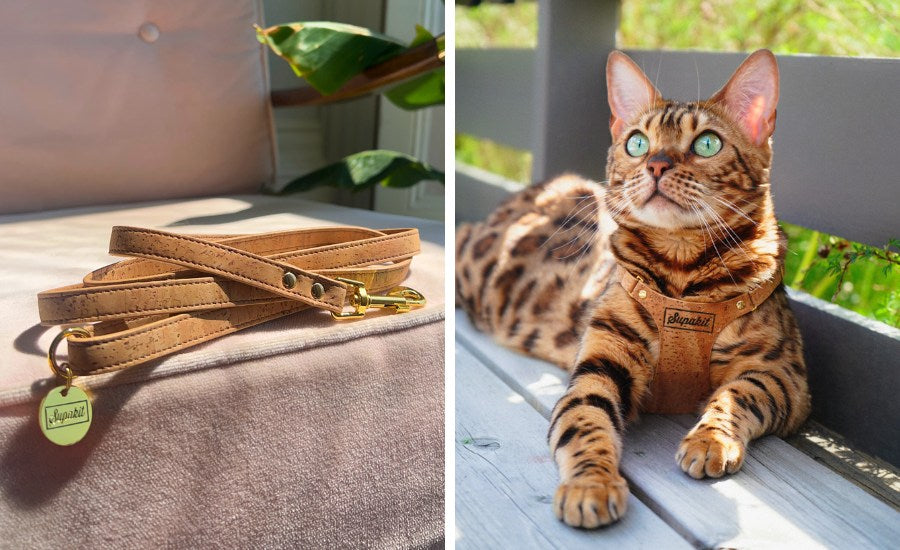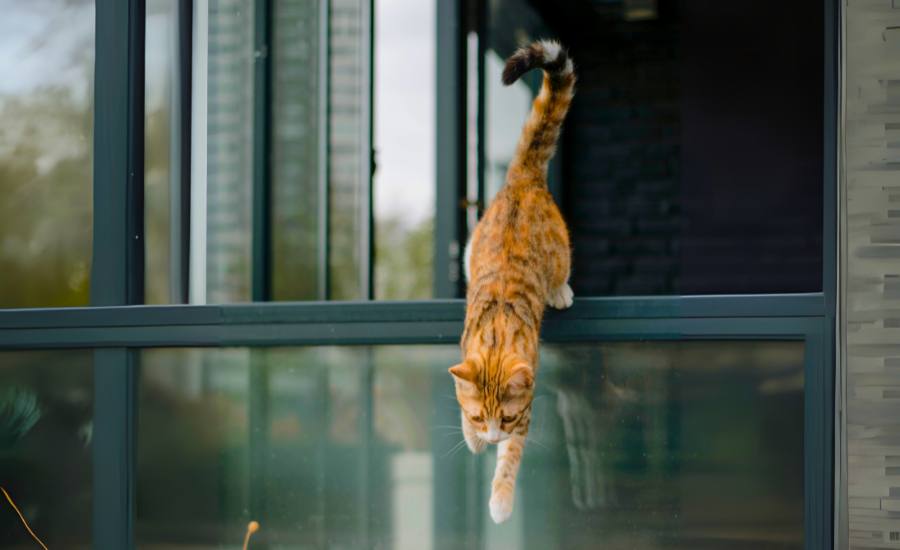Are Cat Collars Safe?
As a caring cat owner, you want to do the best for your cat - but should that include a collar and ID tag, or are they better off without? The question of whether cat collars are safe can stir up a lot of debate and as a result you might be unsure about what to do!
But amidst all of the controversy and confusion there's actually solid facts and science available about whether cat collars are safe, and today we're going to share these with you - so that you can make up your own mind about whether a collar and ID tag is the right choice for your awesome cat.
Scroll down to read our comprehensive guide or click below to watch on YouTube.
Are Cat Collars Dangerous?
Let’s start by looking at the safety record of cat collars. You might have heard some of the awful stories of cats getting strangled or caught up in their collars, or sustaining injuries from getting a paw through their collar band. Where do these come from?
Historically, cat collars were essentially downsized versions of dog collars, featuring a basic design with a traditional fixed buckle fastening. These cat collars without a safety release weren't very safe, but they weren't that popular either so didn't receive much attention.
However, the landscape changed with the introduction of flea collars in the 1970s and '80s.
Are Cat Flea Collars Safe?

Cat flea collars are impregnated with a chemical able to ward off fleas. When cat flea collars were first introduced to the market, their popularity soared as cat owners eagerly sought effective solutions for controlling pests on their pets. But these flea collars were still just fixed collars with no safety features included.
As a result, there was a distressing rise in collar-related injuries. In response, concerned veterinarians started a public awareness campaign to warn cat owners about the associated risks. This is why you're very likely to have heard of distressing stories about cats being injured by their (non-safety) collars and to have heard vets warning against collar use.
But that's not the end of the story, because collar design has come on since then. Realising that fixed band collars aren't safe for adventurous felines, cat collar designers began to explore safer alternatives. This resulted in the creation of two new designs - the elasticated collar and the breakaway cat collar:
Elastic Cat Collars (Stretch Cat Collars)

Elasticated cat collars incorporate an elastic section to allow cats to escape if snagged. The idea is that if a cat is caught by their collar, the elastic section will be able to stretch enough for the cat to wriggle free, therefore reducing the risk of strangulation or injury. As we'll see in a moment, however, this logic is sadly flawed and as a result, elastic cat collars are not the safe choice their designers hoped they'd be.
Breakway Cat Collars
Breakaway cat collars (also known as 'quick release cat collars') are specifically designed with a safety mechanism that makes them a safer choice for cats. Equipped with a breakaway buckle, these collars automatically open under sufficient force, such as when a cat gets snagged or caught. This feature is crucial, ensuring that cats can quickly escape from dangerous situations without the risk of strangulation or injury.
It's common for people to hesitate when considering breakaway collars, fearing they might come off too easily during regular activities. However, with the right collar design, fit and introduction, the likelihood of accidental loss is minimised. For guidance on preventing collar loss and ensuring your cat's safety, visit our comprehensive collar loss guide here.
What is the Safest Cat Collar?

In 2013 a team of scientists embarked on a study to identify the safest type of cat collar (1). They surveyed 107 veterinarians about incidences of collar related injury that they’d seen in their practices. Collectively, the vets had been practicing for over a millennium and a half, so they had seen a LOT of cats and were very well placed to report on collar safety incidents!
In this study, the vets overall had seen 686 collar safety incidents, in which one sadly resulted in the cat passing away. That might sound a lot, but remember that’s in a whole millennium and a half of experience, so it works out as each vet seeing one non-fatal incident every 2.3 years. However, of the cases where the type of collar had been recorded, it becomes clear that not all collars were causing these injuries.
- 42% of injuries were caused by flea collars
- 39% were caused by elasticated collars – people thought that letting the collar stretch would be helpful but actually vets were finding that cats were able to stretch the collar enoguh to get a paw through and then got stuck, leading to injuries.
- 18% were caused by traditional collars with a fixed buckle
And no injuries were associated with cats wearing a breakaway buckle collar. This study showed that breakway cat collars are the safe choice.
Are Cat Collars a Good Idea?
Even with the safety of breakaway collars established, you might wonder whether your cat really needs one.
Here's a telling statistic: one study (2) found that less than 2% of lost cats entering shelters are reunited with their owners, in contrast to the 15-19% reunification rate for dogs. This gap is largely due to cats being less likely to wear visible ID tags, despite similar rates of microchipping between cats (7%) and dogs (8%).
Microchipping your cat is essential (please don't skip this step), but adding a collar and ID tag on top offers immediate, visible identification that a microchip alone cannot provide. Without a collar, a lost microchipped cat could be mistaken for a stray, leading well-intentioned finders to simply assume that your cat is a community cat, or instead to feed them or take them in.
In contrast, a collar with an ID tag clearly signifies ownership, facilitating a quick reunion by providing the finder with a direct and easy way to contact you and bring your missing cat home.
This is particularly crucial for indoor cats, who represent up to 40% of the missing cat population (3) and face their own set of risks. An ID tag that states "I shouldn't be outside" acts as a clear message to anyone who finds them, guiding the next steps to ensure their safe return.
Cat Collar Safety Tips
We’ve established that breakaway cat collars are the safest type of cat collar. But your cat's collar safety is also determined by the collar that you choose and how you use it. Here are our top tips to make sure your cat's breakaway collar keeps them safe:
-
Correct Fit: Ensure the collar fits properly; it shouldn't be too tight or too loose. At Supakit, we recommend our collars be snug yet comfortable, allowing just one fingertip between the collar and your cat's body. This is crucial because a loose collar can easily catch on objects, increasing the risk of it falling off. Regularly rechecking the fit of your cat's collar is essential to maintain the perfect balance.
-
Correct Introduction: Remember, cats need to learn to wear collars. A gentle and gradual introduction is key to ensuring they're comfortable and not prone to fussing with their new accessory. At Supakit, we offer a collar introduction guide to help your cat adjust without stress.
-
Slimline and Lightweight Design: Opt for a cat collar that's sleek and not burdened with unnecessary bulk or accessories. A slimline, lightweight collar minimises the risk of snagging by ensuring a close fit to your cat's body, promoting both safety and comfort.
-
Appropriate Breakaway Buckle: Choose a breakaway cat collar suited to your cat's body weight. The collar's breakaway mechanism is designed to open when a certain amount of pressure is applied. This feature is vital for your cat's safety, allowing them to escape from potentially dangerous situations. For adult cats, a collar that requires at least 2.5kg / 5.5lbs to release is standard, while Supakit offers a special kitten collar designed to open at a lighter weight of 1kg / 2.2lbs. Ensuring the collar's breaking weight matches or is lower than your cat's weight is crucial for the safety mechanism to function correctly.
Are Cat Calming Collars Safe?
A collar is only as safe as the safety features it incorporates. Avoid cat calming collars with a fixed buckle or an elasticated safety release as studies have shown that these are associated with injuries. Instead, look for cat calming collars with a breakaway buckle, and make sure you follow the collar fitting and introduction guidelines to make sure your cat is safe in their collar at all times.
Conclusion
In conclusion, studies have conclusively shown that breakaway cat collars are safe. Combining your cat's microchip with a breakaway collar and ID tag is the best way to help bring your cat home should they ever go missing. We hope this guide has been informative and helpful in addressing your concerns. For further insights and related content, feel free to explore the links below:
References
- Calver, M., Adams, G., Clark, W., & Pollock, K. (2013). Assessing the safety of collars used to attach predation deterrent devices and ID tags to pet cats. In Animal Welfare (Vol. 22, Issue 1, pp. 95–105). Cambridge University Press (CUP). https://doi.org/10.7120/09627286.22.1...
- Lord, L. K., Griffin, B., Slater, M. R., & Levy, J. K. (2010). Evaluation of collars and microchips for visual and permanent identification of pet cats. In Journal of the American Veterinary Medical Association (Vol. 237, Issue 4, pp. 387–394). American Veterinary Medical Association (AVMA). https://doi.org/10.2460/javma.237.4.387
- Lord, L. K., Wittum, T. E., Ferketich, A. K., Funk, J. A., & Rajala-Schultz, P. J. (2007). Search and identification methods that owners use to find a lost cat. In Journal of the American Veterinary Medical Association (Vol. 230, Issue 2, pp. 217–220). American Veterinary Medical Association (AVMA). https://doi.org/10.2460/javma.230.2.217








